Heritage Trail Location 19
The Royal Hotel Spa and the Came Well
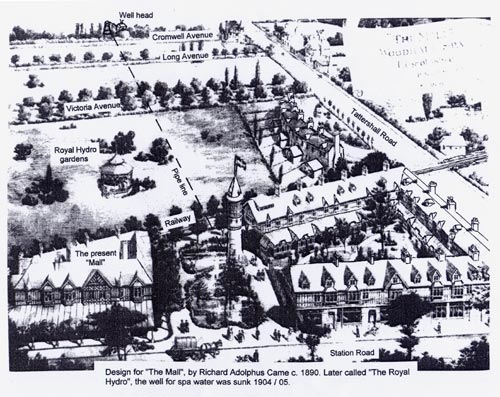
Fig. 1 Projection of the mall and Royal Hotel with the location of the well and pipeline. (Adapted from a design for the Mall by R.A. Came).
The Spa baths was not the only place to have a well to obtain Spa water. Adolphus Came was well aware of the asset a Spa would bring to his Royal Hydro Hotel. The story of the sighting of the shaft and the short lived Spa is quite an unusual story.
Constructing the shaft
In the winter of 1904 to 1905 he sank a shaft, on then waste ground, between Cromwell Avenue and Arnhem Way. (Fig. 1) This was part of a large parcel of land that he had accumulated and hoped to develop as part of the new Woodhall Spa town development. Came knew that the Spa Baths water had been extracted from the Kellaways sandstone at about 520 to 530 feet (about 153 m) where they had encountered a fissure of salt water during its excavation.
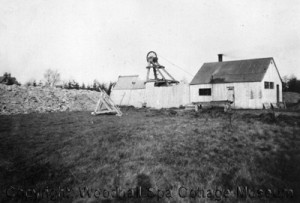
Photo 1. Digging the shaft in the winter of 1904-5. The spoil (left) was used to construct a pond into which the spa water was pumped to allow any clay to settle, before being fed by gravity to the Royal Hotel. (Photo courtesy Woodhall Spa Cottage Museum)
Came chose the site for his well by observing that the snow didn’t settle around the Spa Baths one winter. He reasoned that this was because the “stream” of water running through the fissure kept the ground warm so the snow did not settle. He traced this band of snow free land through Woodhall Spa onto his land and concluded that this marked the line of the underground stream or fissure encountered in the Spa Baths shaft. He then sank a brick lined shaft down to the Kellaways sandstone, the presumed source of the Woodhall Spa water. He encountered the Spa Water at 492 ft.(151 m.). At a depth of 159 m, he constructed two horizontal shafts (adits), each 1.8 m high running 30.6 m (100 feet) WSW to ENE with a 15.3 m (50 foot) bend to the SSE, see plan (Fig. 3) The adits were lined with widely spaced bricks to prevent collapse but allow the water to percolate into the adits. He then continued the shaft downwards into the underlying Kellaways Clay to form a sump where any debris that fell into the shaft could collect without blocking the adits. Above the adits, the shaft was brick lined back to the surface. Total depth was 164.3 m (536 feet).
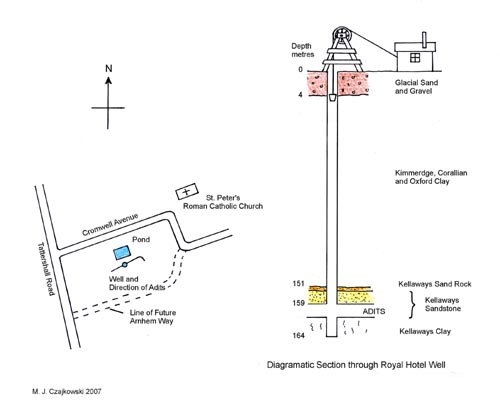
Fig. 2. Royal Hotel location and Well Section. The horizontal adits were constructed at the base of the Kellaways Sandstone to retreave as much water as possible. They extended E-SE and N-NW (see text). The pond allowed any mud and clay brought up with the water to settle. The clean water was then pumped off.
Whilst digging the shaft, the shaft had to be pumped clear of water using the steam engine. The water, and some of the mud, was pumped into the stream (which is named The Sewer) just to the south. This discoloured the water and added a lot of silt into the water. This resulted in neighbouring farmers, who used the stream for their cattle, to complain, as did the local drainage board since the stream drained extensive farm land to the west. This resulted in several arguments and a court case which Adolphus Came lost.
In the area of the well, Came constructed a large elevated pond using the clay extracted from the well to construct the banks. Part of one of the banks still exists in one of the gardens off Cromwell Avenue. This pond was necessary to settle any clay that was pumped out with the water, so the clean water could then be drawn off. This water was then fed through pipes that ran underground to his Royal Hotel. This entailed laying pipes under the railway line. To do this Came was involved with several protracted negotiations regarding payment for the rights to cross the railway land.
The Royal Hotel Spa
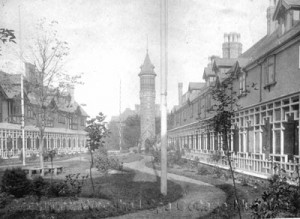
Photo 2. The water tower as seen from the Royal Hotel Winter Gardens in about 1910. Spa water was pumped to the top to give some water pressure when the water was used for treatments. (Photo courtesy Woodhall Spa Cottage Museum)
The water was stored in a converted cellar of the hotel, the walls of which had been lined with pitch. To obtain a working head of spa water a tower (Fig. 4) was built in the grounds and the water pumped up into a tank at the top.
The Royal Hotel Spa was advertised in the Horncastle and Woodhall Spa News that it would open on 24 November1906. It closed during the First World War when the hotel closed. The water quality was highly rated as being similar to Spa Bath water, richer in iodine and bromine, and described as “with the addition of Epsum salts” (Fig. 5) because it was much richer in sulphate that the Spa Bath’s water, which gave the water a slight effervescence. It was hailed as being of considerable benefit to those suffering from a variety of ailments.
At the time, Came was criticized for being in competition with the Spa Baths. However, he pointed out that the Spa Baths closed during the winter whilst his spa did not; this was despite the fact that, like the Spa Baths the rate of water flow was very low. Came therefore, insisted that his well complimented rather than detracted from the Spa Baths.
Post First World War
Although the hotel opened after the First World War, the spa remained closed and the spa system and well was neglected. During the Second World War the well and adjoining hut, which still housed the remains of the steam engine, was used by the Home Guard as a base and to store munitions. They built a stage some distance down from the top and also fixed a set of ladders. One or two of the men climbed down as far as they could (there was water at the bottom) to investigate. They came back with fragments of coalified material, the classic indications which led the original prospectors to look for coal in the area in the first place. The surrounding scrubland, which had grown up in the field, acted as a small base, where small arms fire practice could be carried out, and at the end of the war many hand grenades were dropped down the well to get rid of them.
In the 1960s and 70s, the housing estate of Arnhem Way was built on the field and the well filled in.
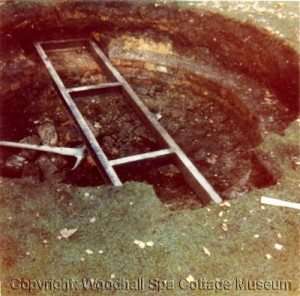 However the well had the last laugh. In 1974, a resident was mowing his garden when suddenly a small depression in his back lawn dropped downwards, revealing the outline of the shaft (Fig. 6). The shaft had been filled with rouble and tree stumps which had since settled. To prevent further collapse, a concrete raft was built across the well.
However the well had the last laugh. In 1974, a resident was mowing his garden when suddenly a small depression in his back lawn dropped downwards, revealing the outline of the shaft (Fig. 6). The shaft had been filled with rouble and tree stumps which had since settled. To prevent further collapse, a concrete raft was built across the well.
Heritage Trail locations
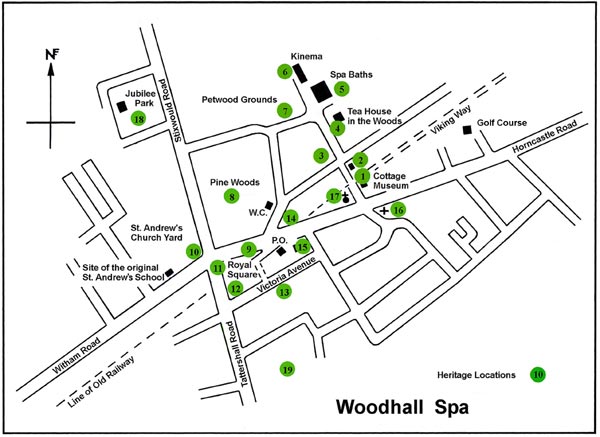
The trail can be started at any location, but we suggest you also visit the Cottage Museum to see the photographs taken by John Wield during the heyday of the Spa and items associated with this unique Victorian Spa town.
The Trail is just one of several projects in the hands of the Woodhall Spa Parish Council sponsored Heritage Committee. Click here if you are interested in the committee or their projects.
How well do you know Woodhall Spa?
See if you can identify the location of these architectural features and items of street furniture! Or find the Letterbox (coming soon).
Find out more about the Woodhall Spa Conservation Area